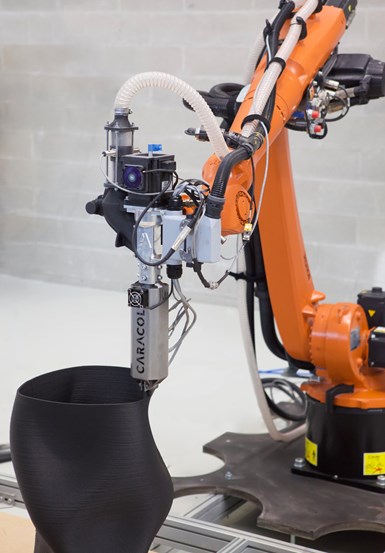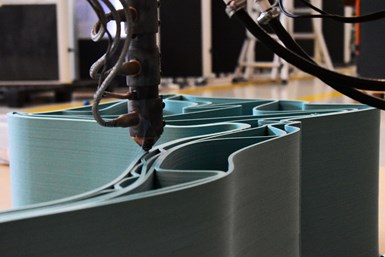Caracol AM launches new identity, celebrates composites applications
Italian supplier of Heron large format additive manufacturing (LFAM) technology showcases circular economy and aerospace applications.
Large-format additive manufacturing printing capabilities (top images and left), and the composite satellite tank for customer, D-Orbit. Photo Credit, all images: Caracol
Caracol’s (Barlassina, Italy) journey of relentless innovation in the large-format additive manufacturing (LFAM) space for more than seven years has led the company to grow from startup to scale-up. “Evolving is at the core of what do every day. We continuously strive to undergo technological and organizational evolution to bring large format AM to the most advanced industries,” Francesco De Stefano, CEO and co-founder of Caracol AM, says. “After our startup journey working hard to create and grow our market, today we celebrate an amazing milestone. A new home, a new identity, a growing team: All these aspects are embedded in Heron AM, the tangible technological symbol of our evolution.”
Heron AM is an integrated hardware and software LFAM platform developed 100% in-house by Caracol as an application-first approach for companies working in advanced sectors, such as aerospace, automotive, marine, energy and more. It features a robotized extrusion head with direct and continuous feeding of composites and polymers, a dedicated software platform for complex toolpaths and other features for the flexible manufacture of advanced industrial parts on-demand and in-situ.
More specifically, the system is able to produce components with a wide range of thermoplastics and composites (both from virgin and recycled origins) in the form of pellets and shreds. According to Caracol, this makes Heron AM ideal for the production of medium- to large-scale parts, such as: structural elements, tooling (e.g., jigs for positioning, drilling and cutting, molds, assembly rigs, beams), prototypes, metal replacement, temporary or permanent substitution of parts and an array of other applications and components.
The company notes years and research and development (R&D) that have gone into Heron AM, with more than 29,000 hours of printing and 150+ project with clients across sectors. Caracol says Heron AM is now on the market. The company will be working with clients to identify applications, opportunities, and manufacture complex parts, as well as provide clients
with a solution to internalize the technology in their own production space.
Caracol also announces that the company has moved into its new headquarters in Barlassina, Italy, which has enabled Caracol to expand its team and technologies. Barlassina is now home to a growing team of more than 35 individuals, each with a set of diverse backgrounds, skills and capabilities — the key to Caracol’s success, the company says. It is also home to more than seven Heron AM platforms in varied configurations, including insulated cells for high-performing polymers or a seven-axis structure to extend part printing capabilities to up to 15 meters. The dedicated space features a post-production area, with robotic CNC, as well as a quality department, with state-of-the-art equipment to inspect and control both the process and all manufactured parts, in accordance with the AS/EN 9100 standard.
Highlighted on the new Caracol AM website are three case histories which showcase what the company’s technologies — including Heron AM — can achieve.
Caracol AM believes such tools will become even more common as the aerospace industry seeks to become more digitalized, efficient and sustainable.
Beluga, for example, is reported to be the world’s first 3D-printed sailing boat produced in one piece with Beyond MyReplast recycled material, developed as a joint project by Caracol and NextChem (Rome, Italy). Caracol wanted to show how its technology could enable the manufacturing of advanced parts with upcycled materials — in this case, recycled polypropylene (PP) with 30% glass fiber. The 3D-printed MyReplast material used for Beluga was recovered through upcycling processes and is an example of how recycled polymers can be used successfully to produce advanced components with high-performance requirements, according to the company.
Beluga also demonstrates extrusion at a high speed — the whole boat was produced in only 40 hours. Caracol’s Heron AM robotic system enables production of applications with very complex and ultra-lightweight geometries. Thanks to the proprietary algorithms it has developed, the extrusion head can be flexibly oriented to different angles, such as 45°. This enables the production of parts with completely suspended surfaces, with hollow, light and geometrically complex structures. Meanwhile, the traditional methods of building molds and then figuring out disposal are eliminated, the company notes. Beluga’s hull was printed in a single piece, an example not only of reduced waste and cost, but of the innovation necessary in future manufacturing.
Caracol AM also produced an aerospace tooling fixture used for positioning and holding aircraft fuselage panels during drilling. The fixture measures 85 x 125 x 33 centimeters (width, length, height) and was printed as a single piece, reducing 30 components to one, which the company says greatly reduced assembly. Finished with CNC milling, the fixture met the required dimensional tolerance of 0.1 millimeter and surface roughness of 1.6 micrometer. The fixture was manufactured and ready to use in only two weeks, compared to the original two months quoted using traditional processes. Caracol AM not only reduced lead time, but also material waste and a 30-50% reduction in cost. The fixture is also much lighter, which aids logistics because it can be stored and handled with greater ease.
Caracol also points to another interesting LFAM project it took on in the art and design sector for Capitolare — a 900-year old luxury suite tower in Porto Venere, Italy. Caracol was chosen to produce the tower’s interior and exterior furniture and décor, collaborating with Andrea Borlenghi who posed the project, architect Michele Bassi who had the task of restoring the antique tower, designer Federica Cristaudo who provided the inspiration and sketches for the interior environments and the communication studio TOMATO. All pieces were manufactured with glass fiber-reinforced polypropylene (PP). A patented extrusion head, six-axis robotic support and Caracol’s proprietary software platform and automation control system enabled the production of large, monolithic parts with complex and organic geometries.
Another case study, the satellite tank for customer, D-Orbit (Fino Mornasco, Italy), while designed, engineered and manufactured by Caracol AM using fiber fused filament (FFF) printers and carbon fiber lamination rather than LFAM, is just as notable. The tank contains nitrous oxide (N2O) — a gas used in rocket engines and internal combustion engines — at a high pressure up to 210 bar. This tank reduced weight versus previous metal designs and cut production time by 50% compared to standard composite tanks. It also reduced cost by first printing an inner, solid structure using a carbon fiber/polyphenylene sulfide (PPS) material that is said provided high mechanical characteristics and is chemically compatible with the gas. Continuous carbon fiber composite was then filament wound on top, replacing a previous hand layup process and requiring less carbon fiber.
Caracol AM believes such tools will become even more common as the aerospace industry seeks to become more digitalized, efficient and sustainable and to take advantage of benefits like production flexibility, weight and cost reduction that LFAM technology offers.
Related Content
Plant tour: Joby Aviation, Marina, Calif., U.S.
As the advanced air mobility market begins to take shape, market leader Joby Aviation works to industrialize composites manufacturing for its first-generation, composites-intensive, all-electric air taxi.
Read MoreThermoplastic composites welding advances for more sustainable airframes
Multiple demonstrators help various welding technologies approach TRL 6 in the quest for lighter weight, lower cost.
Read MorePlant tour: Albany Engineered Composites, Rochester, N.H., U.S.
Efficient, high-quality, well-controlled composites manufacturing at volume is the mantra for this 3D weaving specialist.
Read MoreOne-piece, one-shot, 17-meter wing spar for high-rate aircraft manufacture
GKN Aerospace has spent the last five years developing materials strategies and resin transfer molding (RTM) for an aircraft trailing edge wing spar for the Airbus Wing of Tomorrow program.
Read MoreRead Next
From the CW Archives: The tale of the thermoplastic cryotank
In 2006, guest columnist Bob Hartunian related the story of his efforts two decades prior, while at McDonnell Douglas, to develop a thermoplastic composite crytank for hydrogen storage. He learned a lot of lessons.
Read MoreCW’s 2024 Top Shops survey offers new approach to benchmarking
Respondents that complete the survey by April 30, 2024, have the chance to be recognized as an honoree.
Read MoreComposites end markets: Energy (2024)
Composites are used widely in oil/gas, wind and other renewable energy applications. Despite market challenges, growth potential and innovation for composites continue.
Read More





















.jpg;maxWidth=300;quality=90)












